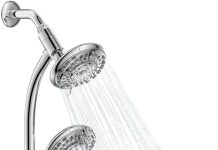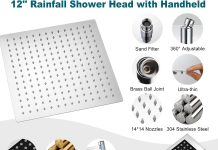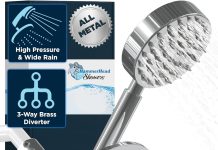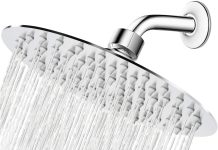Are you tired of your old, lackluster shower head? Are you looking to upgrade your bathing experience with a new and invigorating spray? Look no further! In this article, we have got you covered on all you need to know about installing a new shower head. From gathering the necessary tools to step-by-step instructions, we will guide you through the process seamlessly, ensuring you can enjoy a refreshing shower in no time. Say goodbye to the old and hello to the new as we embark on this easy and rewarding DIY project together.
Table of Contents
Choosing the Right Shower Head
Consider Water Pressure and Flow Rate
When choosing a new shower head, it’s essential to consider the water pressure and flow rate in your home. Different shower heads have varying capabilities to handle different water pressure levels. If you have low water pressure, selecting a shower head specifically designed for low-pressure environments is crucial. On the other hand, if you have high water pressure, you may want to opt for a shower head that can regulate the flow and prevent excessive water wastage. By matching the water pressure and flow rate with the appropriate shower head, you can optimize your showering experience.
Decide on the Type of Shower Head
Shower heads come in various types, each offering a unique showering experience. Understanding the different types available will help you make a more informed decision. Some common types include:
-
Wall-mounted shower heads: These are the traditional and most common type of shower heads, which are fixed to the wall.
-
Handheld shower heads: These shower heads are attached to a flexible hose, allowing you to remove them from the wall and direct the water flow at different angles.
-
Rainfall shower heads: These shower heads simulate the relaxing sensation of rainfall, providing a gentle and soothing flow of water.
-
Water-saving shower heads: These shower heads are designed to conserve water without compromising on the showering experience. They often incorporate features such as aerators or flow restrictors to reduce water usage.
Decide which type of shower head aligns best with your preferences and needs, while also considering the design and functionality of your bathroom.
Choose the Material and Finish
Shower heads are available in various materials and finishes, allowing you to find one that suits your aesthetic preferences. Common materials include chrome, stainless steel, brass, and plastic. Each material offers different advantages in terms of durability, corrosion resistance, and overall appearance. Additionally, consider the finish of the shower head, whether it be polished, brushed, or matte. By selecting the right material and finish, you can enhance the visual appeal of your bathroom while ensuring long-lasting quality.
Gathering the Necessary Tools and Materials
Check Your Existing Shower Head
Before proceeding with the installation, it’s crucial to check your existing shower head. Determine how it is attached to the shower arm – whether it is screwed on or uses a different fastening mechanism. This will help you gather the necessary tools for the removal and installation process.
Prepare the Required Tools
To install a new shower head, you will need a few basic tools. Prepare a wrench or pliers, adjustable or fixed, depending on the type of fastening used for your existing shower head. Additionally, keep a cloth or rag nearby to protect the shower arm during the removal process.
Purchase the Required Materials
In addition to the tools, you will need a few materials to complete the installation. These may include a new shower head, plumber’s tape, and a cleaning solution. Ensure you have all the necessary materials before beginning the installation to avoid any delays.
Removing the Existing Shower Head
Turn Off the Water Supply
Before removing the shower head, it’s crucial to turn off the water supply. Locate the shut-off valve for your shower and close it to prevent any water from flowing during the removal process. This step is essential to avoid potential leaks or water damage.
Protect the Shower Arm
To protect the shower arm from scratches or damage, it’s advisable to cover it with a cloth or rag. This will act as a cushion and prevent any accidental marks while loosening the shower head.
Use the Appropriate Tool to Loosen the Shower Head
Using the wrench or pliers, depending on the type of fastening, grip the shower head firmly and turn it counterclockwise to loosen it. Apply gentle, steady pressure to prevent any damage to the shower arm or surrounding fixtures. If the shower head is particularly tight, you may need to enlist the help of a second person to hold the shower arm steady while you loosen it.
Remove the Shower Head
Once the shower head is sufficiently loosened, you should be able to remove it by twisting it further counterclockwise. It may require some force, but be careful not to use excessive strength that could cause damage. Once removed, inspect the shower arm for any debris or residue that may need cleaning before proceeding with the installation of the new shower head.
Preparing the Shower Arm for Installation
Clean the Threaded Port
After removing the old shower head, it’s important to clean the threaded port of the shower arm. Use a cloth or brush to remove any debris, residue, or old plumbers tape that may have accumulated over time. This step ensures a clean and proper connection between the shower arm and the new shower head.
Apply Plumber’s Tape on the Threaded Port
To prevent leaks and ensure a tight seal, it’s recommended to apply plumber’s tape on the threaded port of the shower arm. Wrap the tape around the threads in a clockwise direction, ensuring a snug fit. Plumber’s tape helps create a watertight seal and minimizes the risk of leaks.
Installing the New Shower Head
Attach the New Shower Head onto the Shower Arm
Once the shower arm is clean and prepared, it’s time to install the new shower head. Carefully align the threads of the new shower head with the threaded port on the shower arm. Begin by hand-tightening the shower head, rotating it clockwise until it feels secure.
Hand-Tighten the Shower Head
Using your hand strength, tighten the shower head as much as possible. Ensure it is snugly fitted onto the shower arm, but avoid over-tightening, as it may cause damage or leaks. Hand-tightening is usually sufficient to create a secure connection. However, if your shower head requires additional tightening, refer to the manufacturer’s instructions.
Secure the Shower Head with a Wrench (if necessary)
If the shower head still feels loose or if the manufacturer’s instructions recommend further tightening, use a wrench or pliers to secure it. Be cautious not to overtighten, as this can damage the shower head or the shower arm. Place a cloth or rag over the shower head to protect the finish, and use the wrench or pliers to provide the necessary torque for a secure fit.
Checking for Leaks and Proper Functioning
Turn on the Water Supply
After the installation is complete, it’s time to turn on the water supply to test the new shower head. Slowly open the shut-off valve and allow the water to flow through the shower head. This step will help identify any leaks or other issues that may require further adjustments or sealing.
Inspect for Any Leaks
Carefully inspect the connections of the new shower head and the shower arm for any signs of leaks. Check around the threaded port, the joint between the shower head and the shower arm, and any visible gaps. Even small leaks can lead to water damage over time, so it’s crucial to address them promptly.
Test the Shower Head’s Functionality
Finally, test the functionality of the new shower head by adjusting the water flow and spray patterns. Ensure the water pressure and flow rate are to your liking. Pay attention to any unusual noises, such as rattling or sputtering, which may indicate an issue with the installation or the shower head itself.
Extra Tips and Considerations
Clean the Shower Head Regularly
To maintain optimal performance and water flow, it’s important to clean your shower head regularly. Over time, mineral deposits and debris can accumulate, affecting the spray patterns and reducing water pressure. Depending on your water quality, this may need to be done more frequently. Remove the shower head periodically and soak it in a mixture of vinegar and water to dissolve any mineral deposits. Scrub with a soft brush to remove any remaining residue, and rinse thoroughly before reinstalling.
Consider Using a Water-Saving Shower Head
In an effort to conserve water and reduce utility bills, consider using a water-saving shower head. These shower heads are designed to limit water flow without compromising the showering experience. They often incorporate features such as aerators or flow restrictors that help regulate water usage. By using a water-saving shower head, you can contribute to environmental conservation while still enjoying a refreshing shower.
Installing a new shower head can be a straightforward process with the right tools and guidance. By considering factors such as water pressure, selecting the appropriate type and material, and following the step-by-step installation procedure, you can enhance your showering experience and update the look of your bathroom. Remember to check for any leaks or issues after installation and clean your shower head regularly to maintain optimal performance. With these tips and considerations, you’ll be well-equipped to choose and install the perfect shower head for your needs. Happy showering!






















